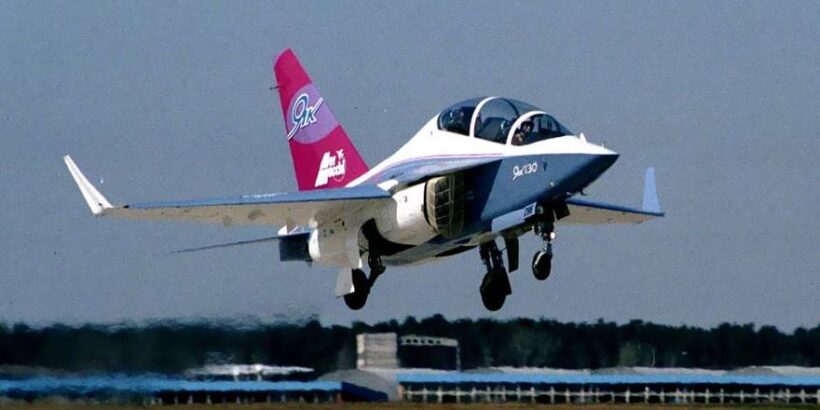The Yak-130 twin-seat advanced jet trainer provides basic and advanced pilot training for modern and future combat aircraft, including highly manoeuvrable 4++ and fifth-generation fighters.
In the early 1990s, the Yakovlev Design Bureau (OKB) approached the development of the future aircraft with a comprehensive solution for creating a training complex. This included display classrooms, PC-based procedural trainers, and functional simulators, all integrated by common software.
To ensure the future Yak-130 could fly at high angles of attack, a moderately swept wing with a small aspect ratio and prominent leading-edge extensions (LEX) was chosen. Initially, the UTS-Yak was intended to be equipped with AI-25TL turbofan engines, as used on the Yak-40 airliner, with a future transition to prospective RD-35 or R120-300 engines. Considerable emphasis was placed on the aircraft’s ease of use and autonomy.
In 1993, amidst the collapse of the USSR and a growing economic crisis, the Yakovlev Design Bureau began seeking investors to continue aircraft development. The Italian company L’Alenia Aermacchi showed interest in the new UAT (Utchebno-Aviatsionnyy Trenazhor – training aircraft complex) project. At that time, Europe had announced the Eurotrainer programme, which envisioned creating a unified UAT for several countries. This could be a major order worth competing for. The Yak-130 was a potential candidate, and the Italians hoped to participate in the pan-European competition by slightly modifying the project purchased from Russia.
In accordance with European requirements, the aircraft’s maximum speed needed to be increased to at least 1,050 km/h – in this case, it could successfully compete with the British Hawk. A second factor concerned the weight of the combat payload, which had to be at least 1.5-2 tonnes. It was also necessary to ensure that the aircraft could operate from third-class airfields with a runway length of no more than 1 km. The machine’s range and ability to carry air-to-surface armament were also important, for which seven hardpoints were provided.
Thus, the requirements that the Italian partners presented, based on the global development of advanced trainer aviation, had to be met. By the mid-2000s, there would no longer be demand for a pure trainer; only advanced trainer aircraft would be in demand on the market. The powerplant selected was the RD-35 turbofan engine, providing 2,200 kgf of thrust each.
By the summer of 1995, the Yak-130D demonstrator was fully ready and was shown at the Paris Air Show in June of that year. As the aircraft had not yet flown, it was transported to Paris aboard a transport aircraft and displayed only in the static display.
The Yak-130D made its maiden flight on 25th April 1996. At the Zhukovsky Flight Research Institute airfield, it was flown by Yakovlev Design Bureau test pilot Andrei Sinitsyn. This flight lasted 32 minutes at a maximum speed of 350 km/h and an altitude of 2,000 m, simulating an approach with the speed brake deployed, and also included a flypast over the airfield at an altitude of around 200 m, followed by a turn onto the downwind leg. Subsequent tests confirmed the stated flight performance and take-off and landing characteristics, and the possibility of controlled flight at angles of attack of up to 42 degrees.
Over five years of joint work with the Italians, a huge amount of flight testing was carried out at the Aermacchi flight test base. Telemetry equipment was installed on board the aircraft, and the incoming parameters were processed in real-time on the ground.
In total, around 450 flights were performed on the Yak-130D during the trials. In 1999, military pilots trialled it at the GLITS (State Flight Test Centre) in Akhtubinsk. The main volume of testing was completed in 2002, and in mid-2004 the demonstrator aircraft was mothballed, as it had fully fulfilled its purpose. The experience gained was used to refine the configuration of the production aircraft.
The production Yak-130 differs significantly from the Yak-130D. Compared to the demonstrator aircraft, it has more refined aerodynamics, is smaller, has a denser layout, and the structural weight has been reduced. The nose section of the fuselage has changed noticeably: its cross-section has become more rounded to accommodate the Osa or Kopyo radar. Depending on customer requirements, an optical-location station can be installed. Additional pylons have appeared on the wingtips for mounting short-range air-to-air missiles or ECM (Electronic Countermeasures) pods.
Production aircraft are fitted with AI-222-25 engines with a thrust of 2,500 kgf each, representing a significant step forward compared to the RD-35.


